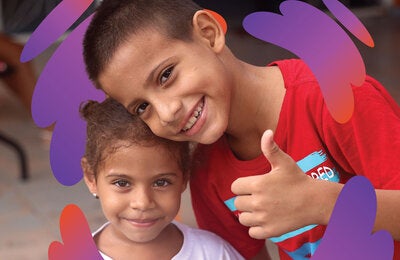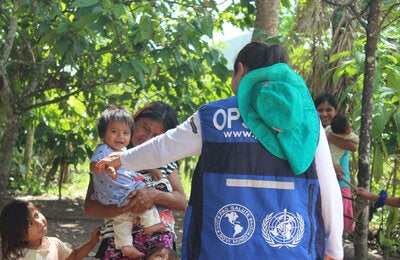
Every year in the Americas, an average of 57,000 new cases of cutaneous leishmaniasis and 3,480 cases of visceral leishmaniasis are diagnosed. In Argentina, the cutaneous form presents a latent risk, while the visceral form has spread from Misiones to other provinces.
Washington, D.C., September 2, 2016 (PAHO/WHO) - A special report on leishmaniasis in the Argentine province of Misiones, published by the Pan American Health Organization (PAHO) in the Pan American Journal of Public Health, offers a series of recommendations for the surveillance and control of this disease, which affects more than 60,000 people in the Americas every year.
Leishmaniasis is a potentially fatal but curable infectious disease caused by a parasite. It belongs to the group of so-called neglected diseases, which mostly affect people living in conditions of vulnerability or in remote areas. It is transmitted to humans by insect bite and takes two forms: visceral, which can be fatal if not treated; and cutaneous, initially showing as a skin lesion but then evolving to skin ulcers and disfigurement, similar to leprosy. The cutaneous form is more common in the Americas and is difficult to cure.
"The study focuses on the need to seek alternative ways to tackle a vector-borne disease for which there are not enough effective control strategies," said Oscar Salomón, principal investigator of the study and director of the National Institute of Tropical Medicine in Misiones, Argentina.
Taking a multidisciplinary approach, the study examined the history of the disease in the area and identified risk scenarios, analyzing various social, biological, and biomedical factors. "Knowing the risk scenarios enables us to define actions for prevention and control," Solomon said.
The study is part of a bigger project in the triple border area that connects Argentina, Paraguay, and Brazil, involving teams from these three countries, as well as Uruguay. The project is led by PAHO and financed through the International Development Research Centre (IDRC) of Canada.
"The knowledge generated through this project will allow us to innovate and design strategies for the surveillance and control of leishmaniasis, and it will contribute to the development of new and innovative tools," said Zaida Yadón, PAHO regional advisor on research on communicable diseases and one of the authors of the article.
Globally, the number of publications on leishmaniasis has increased in recent years. An analysis of the PUBMED database shows that 25% of all publications on the subject have been published in the last five years.
Solomon clarified, however, that studies on the risk factors for leishmaniasis have not translated into tools for its control and that this is an objective of research in the countries of the cross-border study area in the coming year.
The researchers also examined socioeconomic events and processes associated with trends in the disease, such as changes in land use, deforestation, and dam construction, which have had demographic, environmental, and climatic impacts. The researchers found that these phenomena, combined with unplanned urban growth, intense cross-border traffic between Brazil and Paraguay, and interactions between people and infected dogs were associated with vector adaptation, the spread of the disease, and outbreaks.
Leishmaniasis: the current situation
Leishmaniasis continues to be reported in all Latin American countries except for Chile and Uruguay. Every year some 57,000 new cases of cutaneous leishmaniasis are diagnosed, as well as 3,480 cases of the visceral form of the disease, with an average of 220 deaths a year.
According to PAHO data for the period 2001-2013, 75% of the nearly 743,000 recorded cases of cutaneous leishmaniasis in the Americas were concentrated in Brazil (42%), Colombia (20%), and Peru (13%). Of the nearly 45,000 cases of the visceral form reported in the last decade, 96% were in Brazil, 1.9% in Paraguay, 1.3% in Colombia, and 0.3% in Argentina.
The cutaneous form of the disease may have been present in Argentina since pre-Columbian times, but the first formally reported sporadic cases date back only to the early decades of the 20th century, according to the authors. Those cases were located in 10 provinces in the north of the country and associated with the entry of people into wilderness areas for forestry, mining, and fishing. The first outbreak of cutaneous leishmaniasis was reported in the 1980s in the northwest of the country and since then epidemic foci have been registered in that area of transmission.
Visceral leishmaniasis——only 14 scattered cases of which had been recorded in rural areas of the country until 2006——began to spread from the city of Posadas, the capital of Misiones province; by early 2015, 140 cases had been recorded in humans in four provinces and the presence of the vector had been detected in six provinces.
"We were struck by the active spread of visceral leishmaniasis, the insect vector, and infected animals," Solomon said, adding that a "latent risk" of cutaneous leishmaniasis was observed. These findings have led the authorities to take action to mitigate the disease.
Recommendations
The authors of the article, titled La eco-epidemiología retrospectiva como herramienta aplicada a la vigilancia de la leishmaniasis en Misiones, Argentina, 1920-2014 [Retrospective eco-epidemiology as an applied tool for surveillance of leishmaniasis in Misiones, Argentina, 1920-2014], emphasize the need to establish active surveillance to monitor possible increases in parasite and vector circulation; and in the case of an outbreak, the need to conduct studies to confirm indigenous transmission and the intensity of the event.
They also recommend establishing a legal obligation for additional control measures to be adopted by those responsible for projects that involve environmental modifications, such as conducting transmission risk assessment studies and implementing measures for risk mitigation, early detection, and timely case management.
In the meantime, with a view to designing programmatic actions for regions, municipalities, and communities, the authors recommend that studies of the theoretical framework of eco-epidemiology should be conducted, integrating multidisciplinary know-how and multilevel causality.
They point out that this important because the disease is sensitive to climatic conditions and to social and biological changes in the environment and land use, such as deforestation and the construction of roads and hydroelectric plants. All of these tend to extend the insect's habitat and contribute to its adaptation to peri-urban and urban areas, thereby increasing the risk of infection.
No vaccine is available and no single drug completely eliminates the parasite. Treatment includes disease management of the patient, the reduction of the parasite's burden on the body and the resolution of skin or mucosal lesions by the monitored use of the appropriate medicines.
— To read the complete article [in Spanish]
— For more information on the Pan American Journal of Public Health



